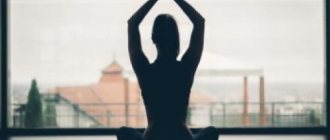Yoga has long been strongly associated with health. Many articles or tips from famous bloggers that talk about a healthy lifestyle include proper nutrition and yoga. However, few people talk about the dangers of yoga, which exist - as in any sport. After all, there are contraindications for activities, for example, bodybuilding or equestrian sports. Therefore, it is important to understand that yoga is not for everyone. The editors of estet-portal.com will talk about how yoga can be dangerous - and how to intelligently approach mastering its asanas so that everything can only benefit you.
- The dangers of yoga: the activity is not for everyone
- Harm of yoga: which asanas are the most dangerous
- Harm of yoga: who should not do it
The dangers of yoga: the activity is not for everyone
Initially, it is worth remembering that yoga is only suitable for people in good physical shape. If you lead a sedentary lifestyle, have never exercised, or do not even do basic morning exercises, this type of activity can be harmful to you.
Subscribe to our channel on Telegram!
Of course, this does not mean that problems will begin from the very first lesson. But they will be - and from this the second fact emerges: yoga was created by Indian practitioners for themselves. And for these people, for example, it is natural to sit in the lotus position, it is like a daily habit. For us, this position is considered exotic - and a small percentage of people can sit in the lotus position without making any serious effort.
Yoga is very dangerous
Yes, some people believe that the very act of getting off their favorite couch will improve their physical fitness. Arriving at the first yoga class in their life, they cheerfully jump into a headstand, actively stretch their legs with their hands and do many other things for which a decent guru would have beaten him with a bamboo stick long ago.
The reality of yoga classes is that the instructor does not always have time to run up to all the zealous yogis and discourage them from jumping into asanas and other sudden movements. So people get injured, and then they spread rumors about the dangers of yoga.
Solution: Don't take advanced classes until you've gained experience. Choose a good lesson for beginners, where they teach work in asanas and adjustments. There you will be taught not to injure yourself.
[back to contents]
Harm of yoga: which asanas are the most dangerous
It can be assumed that those yoga asanas (postures) that are not taught to beginners can be considered dangerous. They are studied at a later level, when a person has already become “involved” in this type of physical activity. However, it is not.
The most dangerous are the simplest asanas, which are taught at the initial stage:
- Downward-facing dog is especially dangerous for people with hypertension and can lead to pain in the cervicothoracic spine.
- Lotus position - dislocation of the hip joint is possible if a person initially has stiff and unstretched thigh muscles, if the stretching is poor.
- Birch - an unprepared person risks getting a spasm of the cervical spine, which can result in damage to blood vessels. It can be so serious that doing the exercise will result in a stroke. Such cases are repeated.
Why is yoga bad for your health?
Yoga, as commonly understood, is guided group exercise, most often consisting of dynamic or static exercises (called asanas).
In the Western world, yoga has grown into a whole branch of sport or fitness; many modern, fashionable, “improved” trends have emerged (power yoga, Pilates, yoga-beat and even “yoga in the air”, etc.).
Over time, more and more new copyright schools of one teacher or another began to appear, promoting their own system under their own name. Nowadays, yoga often becomes the subject of mass marketing, which helps attract a wider audience.
Basically, yoga classes are held in a large hall, where a large number of people of various ages and categories gather; in some cases, groups reach several dozen people. In group classes, people perform (or try to perform) the same exercises, repeating at the same pace after the instructor, while he does not always have the opportunity to monitor the correct execution of asanas. However, it is worth noting that some teachers still pay attention to this and periodically walk around the hall, correcting students.
many people still that having attended group classes, especially for the first time, they had a negative experience: dizziness appeared (or nausea, temperature, blood pressure rose, etc.); and after that they decided: yoga is not for me.
In other cases, people attending group classes 1-2 times a week for a long period did not notice any significant changes in their health, and therefore quit the practice.
Given these trends, I want yoga, in addition to physical activity, to bring real health benefits without creating problems.
Why then do such cases sometimes occur?
Ayurveda can answer this question, according to which yoga is a means of maintaining health, improving the body and preventing diseases.
The main aspects of Ayurveda are the uniqueness of each person and an individual approach, teaching that everyone has their own mental nature, complexion, strength, age, weight, predisposition to diseases. Based on these criteria, everyone is reasonably prescribed their own type of physical activity and the principle of its implementation.
The main criterion by which physical activity is determined is prakriti - the original psycho-physiological constitution of a person. There are three main types of prakriti, according to the dominant energy: Vata, Pitta, Kapha.
For each of them, a different type of asanas (static or dynamic), pranayamas (breathing exercises), and meditations are recommended.
For example, for Vata, excessive dynamism is not recommended, but for Kapha, on the contrary, active physical activity is useful. People with strong Pitta will quickly achieve developed muscles and physical strength, while Vata and Kapha will take longer to achieve this.
The wrong approach to yoga practice for each prakriti leads to corresponding violations. Vata may experience headaches, overexcitability, insomnia, etc.; Pitta may experience increased temperature, blood pressure, and short temper. For Kapha, the wrong approach often manifests itself simply in the absence of results.
It is also necessary to take into account the contraindications that all asanas have without exception. People with spinal hernias, skeletal system injuries, hypertension, and cardiovascular diseases should be especially careful when choosing exercises.
On the other hand, a reasonable approach to yoga can give representatives of each constitution the necessary qualities that they lack. Vata yoga will give balance, strength, and inner warmth. Pitta yoga can provide harmony, neutralize internal heat, and balance blood pressure. Kapha yoga can help you lose weight and gain vigor and energy.
However, it must be borne in mind that most people belong to a mixed type of constitution (Vata-Pitta, Kapha-Vata, Pitta-Kapha, etc.). Therefore, it is necessary to combine the rules, based on the individual recommendation of a specialist in Ayurvedic pulse diagnostics (nadivigyan). A nadivigyan specialist is able to most accurately determine your prakriti and give recommendations for yoga therapy.
Thus, with the right individual approach, yoga can become a powerful means of regulating physical condition, achieving perfect health, evolution of consciousness and inner harmony.
Benefits of yoga
Practice is not just physical exercise, it is practically a way of life, including the philosophy of personal development, physical and spiritual practices.
The physical benefits of practice are achieved through proper breathing, which you need to learn, and static load in special poses - asanas.
In addition, noting the advantages of yoga as a spiritual teaching, it should be noted that through meditation and changing the perception of the world around us, it allows you to change many negative habits and thoughts , and thereby improve the quality of life in general.
Ultimately, the benefits are as follows:
- Blood pressure normalizes and cardiovascular endurance increases
- The physical condition of the body improves: flexible muscle relief is acquired, joint problems go away
- Increases stress resistance and self-control
- Changing lifestyle, negative eating habits, helping to quit smoking and alcohol.
It’s worth clearing right away that only unshakable faith in the technique can bring results and maximize all the benefits of yoga. People who practice for fun, relegating the spiritual component to the background and considering the practice only as a set of physical exercises, will never be able to fully appreciate the mystery and, of course, the effectiveness of the exercises.
Thanks to a special breathing technique during meditation, metabolic processes are regulated, oxygen balance is restored, which has a beneficial effect on the state of the nervous system and psyche.
Yoga poses and their benefits provide complete control over the body and create a meditative state that makes it easier to cope with negative moments in life and calmly respond to unexpected events. The world is becoming brighter, more interesting, more joyful.
Regular exercise has a beneficial effect on the cardiovascular system and blood pressure. There is also a visual effect: due to increased muscle elasticity, the body is tightened and a pleasant relief is created.
The anatomy of yoga implies complete liberation from bad habits and addictions, regulation of nutrition, which undoubtedly has a positive effect on the health of the body, helps cleanse the body and lose weight.
Read similar: Dharma
Men's yoga: a set of asanas for good potency
Tadasana with mula bandha
Place your feet hip-width apart. Feel the support in three points: the heel, the outer edge of the foot, the base of the big toe. Make a light, “tearing” force on the mat with your feet to the sides. Tuck your tailbone. Move the middle of the chest slightly forward and upward. Relax your shoulders and move them down further from your ears. Reach the top of your head towards the ceiling. Bring your body weight a little more toward your heels until you feel a slight sensation of your toes lifting off the mat. Perform mula bandha - tighten the muscles of the perineum. Stay in the pose for 8 breaths .
*instructor clothing provided by Fashion Verdict Sport
Uddiyana bandha
Sit in sukhasana. Tone the perineal muscles. Take a long, deep breath in and out and lower your chin to your chest. Sitting with a straight back and pushing off the floor with your hands, stretch your spine up. Relax your shoulders, abdominal muscles and open your chest. Due to the difference in pressure, the stomach will retract on its own. Do 8 approaches with breath holding . Take long, deep breaths between repetitions.
Janu Sirsasana with Mula Bandha
Sit on the mat, stretch your right leg forward, pull your toes towards you. Bend your left leg and place its foot at the hip or knee of your right leg. If your knee is hanging off the floor, place a support under it to relieve tension in your hip. Tone the perineal muscles. As you exhale, lower yourself forward without rounding your back. Reach your chin toward your right toes. Try to place your stomach on your right thigh. Relax the muscles in your back and back of your right leg. As you inhale, rise up and perform the asana on the other leg. Do 8 sets of 4-6 breathing cycles , alternating legs.
Adho mukha svanasana with uddiyana bandha
Stand in tadasana, place your palms on the floor and walk them forward. Place your palms shoulder-width apart, point your fingers in different directions, and leave your middle fingers parallel to each other. Push your hands off the floor. Keep your shoulders as far away from your ears as possible. Relax your neck, direct your gaze to your navel. Push your tailbone up and your heels down. Feet hip-width apart. The legs are bent at the knees.
Engage the root and throat lock, relax the abdominal muscles and open the chest, the stomach will retract itself. Hold your breath. Relax, take a deep breath and exhale, repeat the exercise. Do 8 sets of holding your breath. Delay time is maximum.
Sarpasana with mula bandha in dynamics
Lie on your stomach on the floor. Raise your body up, tone the muscles of the perineum and gluteal muscles. Feet should touch the floor. Place your hands behind your back and stretch them even further back, thus opening your chest. Relax your shoulders. Direct your gaze in front of you. As you exhale, lower your palms under your shoulders and move into downward-facing dog. Repeat the previous exercise. As you inhale, move into the plank position: emphasis on straight arms, shoulders above your palms, gaze at the floor, tailbone tucked, stomach tucked. As you exhale, lower yourself onto your stomach and repeat the exercise on your next inhalation. Do 6-8 approaches.
Viparita karani mudra with uddiyana bandha
Lie on your back, bend your knees and place your heels closer to your buttocks. Direct your gaze to the ceiling. Push your shoulders and feet off the floor, lift your pelvis up. Place your palms under your sacrum and place your elbows as close to each other as possible. As you inhale, tensing the muscles of the perineum, lift your legs up. Relax your feet. Open your chest as much as possible, bending at the lower back. As you exhale, lower your legs down, lower your hands to the floor and slowly, vertebra by vertebra, lower your back to the floor, the sacrum lies on the mat last. Relax. Do 2 sets of 8 breathing cycles.
Shavasana
Rest in shavasana for 6-8 minutes.
Do yoga and your men's health will not let you down.
* shooting took place at the Moscow Yoga School










